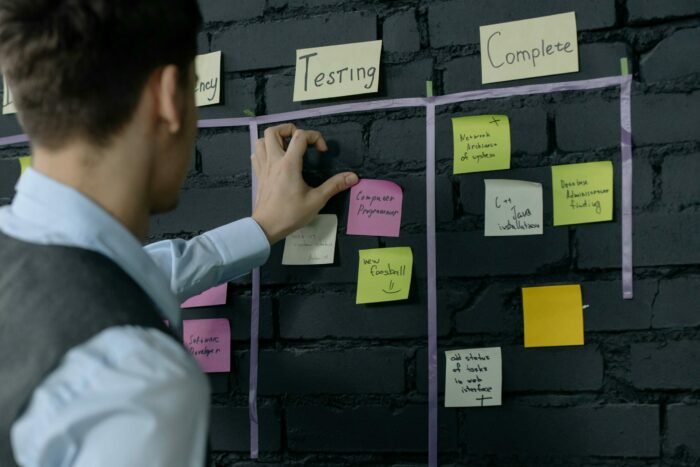Welcome to our article on the hybrid waterfall/agile model, a development methodology that combines the best of both worlds. In today’s fast-paced software development landscape, project management and delivery are crucial for success. Organizations often face the challenge of choosing between the traditional waterfall model and the more flexible agile methodology. But what if there was a way to leverage the strengths of both approaches? That’s where the hybrid waterfall/agile model comes in.
The hybrid approach allows organizations to strike a balance between the structured waterfall model and the adaptable nature of agile methodology. It offers valuable insights for project management, software development, and overall team collaboration. By incorporating both methodologies, organizations can optimize their development process and deliver high-quality products efficiently.
- The hybrid waterfall/agile model combines the structured waterfall methodology with the flexibility of agile methodology.
- It allows for a more adaptable and customizable approach to project management and software development.
- The hybrid model promotes collaboration between teams and facilitates a gradual transition to agile methodology.
- Effective communication, coordination, and continuous improvement are crucial for successful implementation of the hybrid approach.
- The hybrid model offers benefits such as enhanced collaboration, accelerated delivery time, and the ability to maintain compliance with standards.
Understanding the Waterfall Methodology
The Waterfall methodology is a structured project management framework commonly used in software engineering. It follows a linear approach, where each stage of the project is completed before moving on to the next. This traditional methodology is best suited for small projects with clearly defined and stable requirements, allowing for a systematic and sequential development process.
One of the key advantages of the Waterfall methodology is its simplicity and ease of understanding. The linear nature of the project lifecycle, consisting of distinct stages such as requirements gathering, design, development, testing, and deployment, makes it straightforward to manage and track progress.
The Waterfall model also offers better budget management and resource allocation, as it allows for accurate estimation of project timelines and costs. By having predefined milestones and specific deployment dates, organizations can effectively plan and allocate resources throughout the project.
Moreover, the Waterfall methodology promotes a clear scope and well-defined deliverables, reducing the likelihood of scope creep and ensuring project requirements are met. This can lead to fewer production issues and a higher likelihood of meeting customer expectations.
However, the Waterfall methodology has its limitations. It is not well-suited for complex or long-term projects that may require flexibility and adaptability. Since each stage must be completed before moving on to the next, changes in requirements or unexpected discoveries during the project can lead to delays and increased costs.
The rigid nature of the Waterfall model can also hinder collaboration and communication among project stakeholders. Due to the linear progression, there is limited room for feedback and iterative improvements, potentially resulting in a final product that does not fully meet the end-users’ needs.
Understanding the strengths and limitations of the Waterfall methodology is crucial when considering a hybrid approach. By leveraging its advantages and addressing its drawbacks, organizations can effectively incorporate Waterfall practices into a hybrid waterfall/agile model, taking advantage of both structured project management and adaptable development methodologies.
Table: A Comparison of Waterfall and Agile Methodologies
| Waterfall Methodology | Agile Methodology |
|---|---|
| Linear and sequential approach | Iterative and incremental approach |
| Clear scope and defined deliverables | Flexible scope and evolving requirements |
| Accurate estimation of timelines and costs | Less predictable timeline and cost estimations |
| Limited collaboration and feedback | Close collaboration and continuous feedback |
| Well-suited for small projects with known requirements | Ideal for complex projects with evolving requirements |
Embracing the Agile Methodology
The Agile methodology is a flexible and collaborative software development approach that emphasizes iterative development, customer involvement, and adaptability. Unlike traditional approaches, such as the Waterfall model, Agile follows an agile framework that allows for continuous feedback and evolution throughout the software development processes.
Agile is well-suited for projects that have dynamic requirements and evolving priorities. It empowers small-to-medium teams to work independently, think quickly, and be flexible in response to changes. Through fast deployments and iterative development, Agile encourages experimentation and provides faster feedback to stakeholders.
While Agile offers numerous advantages, it is important to acknowledge that it may not be suitable for all projects. Projects with fixed deadlines, strict budgets, or well-defined requirements may be better suited to a different approach. Understanding the principles and characteristics of Agile is crucial for effectively incorporating it into a hybrid model that combines the benefits of Agile and structured methodologies like Waterfall.
Agile methodology emphasizes collaboration, customer involvement, and iterative development framework, making it well-suited for projects without known deadlines or fixed requirements.
Advantages of Agile Methodology
- Enhanced collaboration: Agile promotes close collaboration between team members and stakeholders throughout the development process, resulting in higher-quality software products.
- Adaptability and flexibility: Agile allows teams to easily respond to changes, accommodate new requirements, and make adjustments as needed.
- Fast deployments: Agile enables frequent and rapid deployments, ensuring that working software is delivered early and continuously throughout the development process.
- Customer satisfaction: Agile prioritizes customer involvement and feedback, ensuring that the final product meets the customer’s needs and expectations.
Challenges of Agile Methodology
- Complexity management: Agile projects can become complex to manage when dealing with numerous iterations, dependencies, and evolving requirements.
- Continuous stakeholder involvement: Agile requires consistent and active participation from stakeholders, which may pose challenges in organizations with limited availability or constrained resources.
- Coordination between teams: When using Agile in a hybrid model, ensuring effective communication and coordination between Agile teams and other teams following different methodologies can be a challenge.
Understanding the advantages and challenges of Agile methodology is essential for making informed decisions about incorporating Agile into a hybrid software development process.
Introducing the Agile-Waterfall Hybrid Model
The Agile-Waterfall hybrid model is an innovative approach that combines the best of both the Agile methodology and the structured Waterfall approach. This hybrid model allows software development teams to work in an Agile manner, while hardware development teams and product managers can adhere to the Waterfall method. By leveraging the strengths of each methodology, this hybrid model promotes collaboration, flexibility, and gradual transition to full Agile implementation.
One of the main advantages of the Agile-Waterfall hybrid model is its ability to accommodate projects with a set budget and delivery date. While the Waterfall model provides structure and predictability, the Agile framework enables fast design, analysis, and planning. This combination empowers teams to deliver high-quality products efficiently.
Implementing the Agile-Waterfall hybrid model requires effective coordination and communication between teams. Software developers can work in short, iterative sprints, while hardware teams can rely on the Waterfall methodology to ensure stability and control in their processes. This collaborative approach fosters cross-functional teamwork and maximizes productivity.
“The Agile-Waterfall hybrid model allowed our organization to strike the perfect balance between structure and flexibility. We were able to meet our project deadlines while also adapting to changing requirements. It truly transformed our project management approach.”
-Emily Martinez, Project Manager at XYZ Company
Adopting the hybrid model requires careful consideration of project requirements, team dynamics, and stakeholder buy-in. It is essential to establish clear guidelines, shared goals, and a common understanding of the hybrid project management approach. Regular retrospectives and continuous improvement practices are crucial to refining and optimizing the hybrid model.
Overall, the Agile-Waterfall hybrid model offers organizations a powerful solution to address the inherent challenges of traditional project management methodologies. By embracing this hybrid approach, businesses can leverage the benefits of both Agile and Waterfall, resulting in more successful and adaptable project outcomes.
| Benefits of the Agile-Waterfall Hybrid Model | Challenges of the Agile-Waterfall Hybrid Model |
|---|---|
|
|
Benefits and Challenges of the Hybrid Approach
The hybrid approach, combining elements of both waterfall and agile methodologies, offers several benefits. One of the key advantages is enhanced collaboration between teams. By integrating the strengths of waterfall and agile, project managers can foster effective communication, promote knowledge sharing, and ensure alignment across different stages of the project. This collaborative environment improves the overall efficiency and effectiveness of the development process.
Another benefit is the accelerated delivery time. The iterative nature of the hybrid model allows for faster turnaround and shorter development cycles. By breaking down large projects into manageable iterations, teams can deliver incremental results while ensuring continuous improvement and feedback. This iterative approach enables early detection of issues and provides opportunities for timely adjustments, resulting in a more streamlined development process.
A significant advantage of the hybrid approach is the ability to maintain compliance with industry standards and regulatory requirements. While agile methodologies are known for their flexibility and adaptability, the structured nature of waterfall methodologies ensures adherence to established protocols and guidelines. This is particularly important for projects in highly regulated industries such as healthcare or finance, where compliance is a top priority.
| Benefits | Challenges |
|---|---|
| Enhanced collaboration | Adapting to different methodologies |
| Accelerated delivery time | Communication and coordination between teams |
| Maintaining compliance with standards | Finding the right balance between Agile and Waterfall |
“The hybrid approach allows organizations to harness the benefits of both waterfall and agile methodologies while mitigating their individual challenges. It empowers teams to collaborate effectively, deliver projects faster, and maintain regulatory compliance. However, the hybrid model requires careful coordination and finding the optimal balance between Agile and Waterfall.”
While the hybrid approach brings numerous benefits, it also presents its own set of challenges. One of the main challenges is the need for teams to adapt to different methodologies. This requires a mindset shift and an understanding of the underlying principles and practices of both waterfall and agile. Without proper training and support, team members may struggle to navigate the hybrid model effectively.
Effective communication and coordination between teams are also crucial elements in the success of the hybrid approach. As teams operate using different methodologies and have distinct processes and timelines, clear and constant communication becomes essential to ensure alignment and avoid any potential bottlenecks or roadblocks. Regular meetings and status updates help foster collaboration and maintain project momentum.
Furthermore, finding the right balance between waterfall and agile practices is essential for optimal project outcomes. Each project is unique, and understanding which aspects of each methodology to prioritize is crucial. In-depth analysis and evaluation of project requirements, team dynamics, and stakeholder buy-in are necessary to strike the right balance and maximize the benefits of the hybrid approach.
Conclusion
The hybrid waterfall/agile model offers organizations a flexible and customizable approach to project management, combining the strengths of both methodologies. By leveraging the hybrid model, we can achieve the benefits of Agile while maintaining the structured nature of the Waterfall model. However, it is crucial to carefully evaluate project requirements and team dynamics to determine if the hybrid approach is the right fit for our organization.
Successful implementation of the hybrid project management framework relies on effective communication, collaboration, and continuous improvement. By fostering open lines of communication and encouraging collaboration among team members, we can overcome the challenges associated with blending the two methodologies.
Ultimately, by adopting the hybrid approach, we can optimize our software development life cycle and deliver high-quality products efficiently. The flexibility and adaptability of Agile, combined with the structure of Waterfall, enable us to break down large projects into manageable iterations while still meeting set budgets and delivery dates.
FAQ
What is the hybrid waterfall/agile model?
The hybrid waterfall/agile model is an approach that combines the structured Waterfall methodology with the adaptability of Agile. It allows for a combination of both methodologies in software development projects.
When is the Waterfall methodology most suitable?
The Waterfall methodology is best suited for small projects with known requirements that are unlikely to change. It follows a linear approach with specific deployment dates and dependent tasks.
What are the advantages of the Agile methodology?
The Agile methodology emphasizes collaboration, customer involvement, and the ability to evolve through iterations. It enables fast deployments, encourages experimentation, and provides faster feedback.
What is the Agile-Waterfall hybrid model?
The Agile-Waterfall hybrid model combines the Agile methodology with the structured Waterfall approach. It allows software development teams to work in an Agile manner while hardware development teams and product managers adhere to the Waterfall method.
What are the benefits of the hybrid approach?
The hybrid approach offers enhanced collaboration, accelerated delivery time, and the ability to maintain compliance with standards. It allows for a more flexible development process, breaking down large projects into manageable iterations.
What are the challenges of the hybrid approach?
The hybrid approach requires teams to adapt to different methodologies, and communication and coordination between teams are crucial. Finding the right balance between Agile and Waterfall and ensuring buy-in from stakeholders is essential for success.
How does the hybrid waterfall/agile model optimize software development?
The hybrid waterfall/agile model provides a flexible and customizable approach to project management. By combining the strengths of both methodologies, organizations can achieve the benefits of Agile while maintaining the structure of Waterfall.










